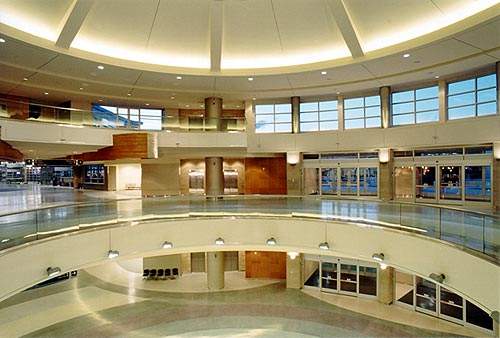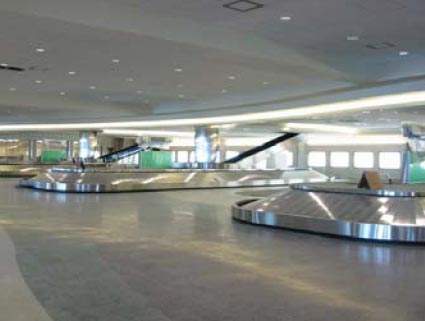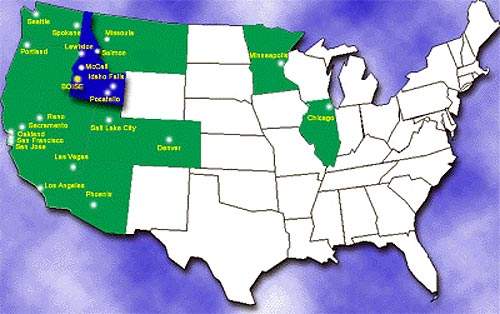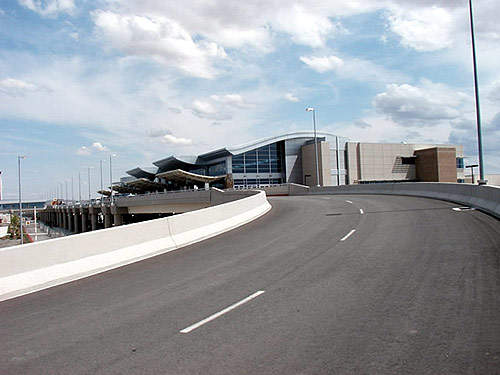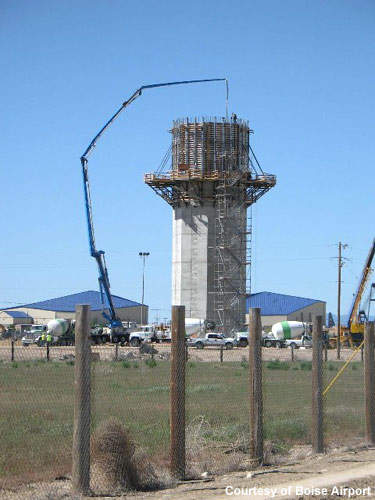
Boise Airport is an important domestic hub for Idaho and the mid-north-west US for passenger and cargo traffic. The airport has connectivity with all major US cities.
The airport experienced unprecedented growth between 1990 and 2000, with passenger numbers doubling to 1.5 million a year. This was due to the number of major employers locating their facilities to the area and the consequent expansion in business traffic. Passenger numbers by August 2011 reached over 1.9 million.
Boise Airport expansion phases
The capacity of the old terminal facilities has been exceeded several times over. The old facilities were also in need of a security upgrade following new regulations adopted at all US airports. A master plan for the airport upgrade was formulated in 1999 and initiated in 2001. The upgrade was undertaken in two phases:
- phase I – which included a new terminal building; a four-lane, two-level road system; expanding the air carrier apron and a new parking facilities – was completed in June 2003.
- phase II included building a new concourse to serve Horizon Air (one of the major carriers to Boise), increasing the number of gates from seven to 13, the completion of new security facilities, constructing a link from the new terminal to the airport concourse, and developing the remainder of the terminal’s retail facilities including rental-car counters and food court/concession facilities. This work was completed in early 2005.
The first phase of the airport expansion cost $100m, which included $40m for the elevated, two-level roadway to the passenger departure area on the second floor. The second phase of the expansion cost $10m.
A new airport development plan (ADP) was initiated in March 2006. The plan consists of four development phases: phase I (2008-12), phase II (2013-17), phase III (2018-22) and phase IV (2023-27).
Phase I of the ASP includes the expansion of the economy lot, parking garage and general aviation area, and the construction of a new runway (10R), exit taxiways, a snow removal equipment facility and a US Customs and Border Protection facility.
Runway 28L and Taxiway B will also be extended by 2012. There are long-term plans under the ADP to expand the terminal and concourse A by 2020.
The construction of a new air traffic control tower began in 2008 as part of the new master plan. It was expected to be commissioned by 2011, but was postponed to 2012-13 because the Federal Aviation Administration (FAA) decided to remodify and add new features to the tower. The tower will be 289ft high and will become the tallest building in the state of Idaho (and the tallest ATC in the Pacific nort-hwest region).
The new ATC has been relocated to the south side of the airport so that it can control an existing guard assault strip and a prospective new runway, which would be constructed south of Gowen Field.
The airport is on course to become a medium-sized hub by 2017 and will lose grant funding available to smaller airports (making alternative funding a large consideration).
Construction of Boise Airport
Boise Airport’s 361,473ft2, three-level terminal building was built with scooped, swooping roof trusses that resemble waves and the building is clad on the outside with architectural stones that give the appearance of rounded river cobblestones. The intention was for the outside appearance to resemble the immediate environment of the airport and to follow a Boise River valley theme. The building is of traditional steel member construction with aluminium composite panels attached to the girders and ‘stone’ cladding attached to the aluminium.
The design has also incorporated a glass enclosed ramp connection from the car park area to the departure area of the main terminal. The construction has given the new terminal an open and airy feeling. There is an overall increase in space of 162%, giving more room for security, with a new spacious security corridor that was outfitted and commissioned in 2004 (phase II).
The baggage-handling carousels have increased in number and size; there are also additional ticket counters and a new car-rental concourse (also completed in phase II).
The two-level, elevated roadway has a four-lane arrivals roadway for private vehicles to the departures area and a two-lane facility on the lower level for commercial vehicles.
Biometric security systems
One of the major requirements of the new security regime currently operated by the Department of Homeland Security (DHS) in US airports is biometric identification. Boise is one of the airports that have introduced a biometric hand-reading verification system. The supplier for this security system was Recognition Systems Inc (RSI), a subsidiary of the Ingersoll-Rand Company Ltd.
The system was installed by AIC Solutions of Boise to integrate with all of the other electronic security systems of the airport, including CCTV and heat sensor equipment. Boise Airport is using the new system to protect and control access to various areas inside the new terminal.
The RSI hand reader can analyse more than 90 unique measurements of the shape and size of a person’s hand. This process takes only a few seconds to complete and the data collected can then be compared to the data collated about an individual on a central database. In this way authorised personnel access to sensitive areas can be monitored.
Security enhancements
Construction of the new terminal began only two months after the terrorist activity of 11 September 2001. The security directives of the FAA and the DHS radically changed the scope of the design of the terminal building. The roof structures had to be raised to accommodate additional luggage screening equipment on a new separate third floor. The new terminal structural steel was strengthened and all of the glass structure modified to enhance safety for passengers.
When the phase I expansion was completed in June 2003, Boise was one of only three airports in the US that was fully compliant with congressional mandates for 100% screening of checked baggage, using state-of-the-art integrated explosive detection equipment.
DigitalSENTRY video storage and control system
The new terminal has an unprecedented number of CCTV cameras in its new system (there are around 580 cameras in the system); reviewing tapes and keeping control of such a system was therefore a major task.
The control and storage system selected was the DigitalSENTRY system, manufactured by Integral Technologies, of Indianapolis. The new system required modifications for it to work with the two different camera configurations at the airport and integrating the access control system was challenging.
DigitalSENTRY is computer-based on a Microsoft platform. The video output from the camera feeds into DigitalSENTRY for digital high-volume storage, while IT personnel monitor the system live on their own computer screens.
The system allows events recorded by each camera to be retrieved quickly by time, date or location. The system also allows pre and post-event viewing. If an access control alarm is triggered, IT personnel can click on a feature on the monitor and see events just before and after the alarm. Each door can have a different alarm time programmed so that viewing pre and post recording is simple.
The DigitalSENTRY system is set to Greenwich Mean Time to avoid confusion about times and time changes. The data is password protected, but the system also has a built-in function that constantly reviews the system to spot any time changes. If an anomaly is found, an alarm is triggered.
The DigitalSENTRY interface is user-friendly enough so that visiting law-enforcement officers can operate the system if IT is not available. All functions are operable via point and click with a mouse.
DigitalSENTRY also allows colour photos to be printed from the camera feed or portions of the tape to be recorded as movie files and saved to a CD. This additional feature has been used extensively. For example, in numerous cases when baggage, laptops and computers were stolen from the baggage claim area, the cameras caught the thieves in the act. IT were able to immediately provide printouts to police, who were then able to stop the guilty parties before they got away.
Boise Airport wireless internet service
In June 2005, MPC Computers, a Gores Technology Group company, announced that it will be the sole corporate sponsor of Boise Airport’s new wireless internet service. Free, secure, high-speed wireless connections is now available to all Boise Airport customers throughout the entire facility.
Contractors
The terminal was designed by two groups of architects based in Boise: CSHQA and HNTB. The expansion was then planned and project managed by Avairpros, who were responsible for keeping the airport running smoothly during construction work.
The construction of the terminal facility’s first and second phases was undertaken by Layton Construction of Sandy, Utah. The exterior cladding and fire proofing of the structural steel for phases 1 and 2 was the responsibility of Interior Systems Inc.
The four-lane, two-level roadway was constructed by McAlvain Construction Inc. The fitting out of the new car parking facilities, which included 1,000 new spaces, was undertaken by Ampco System Parking, which was also responsible for the new car-parking franchise, ground transportation and shuttle services at the airport.
New Boise air traffic control tower
The new 289ft ATC tower will cost around $12.8m as part of a $28m investment into the airport by the FAA. There will also be an upgrade of instrument landing equipment for low visibility and foggy conditions.
The new ATC will replace the 35-year-old 65ft tower that is currently in use (it won the facility of the year award for control towers levels 5-8 from the FAA in 2007). The new ATC has been relocated to a site on the southside of the airport on the corner of Ulm and Harvard St where there will be a better view of a proposed new 5,000ft third runway that is expected to be constructed by 2015. The tower is being constructed by Layton Construction Company and will use a concrete masonry unit system and also Xeriscape landscaping to save water.

